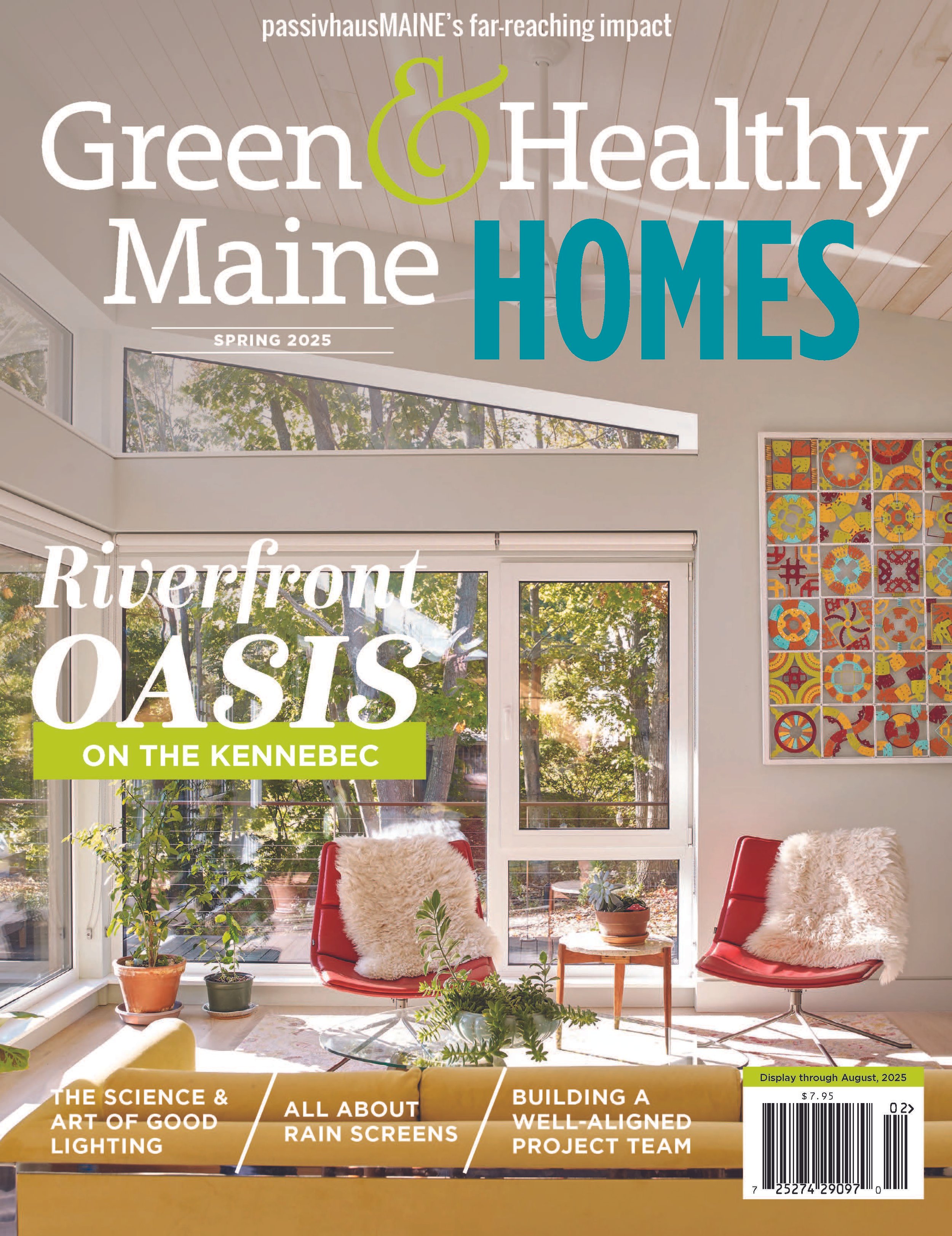Rain screens: What they are and when to use them
Shown: 1 x 4-inch strapping is installed over SIGA Majvest weather-resistive barrier to accommodate the vertical nickel gap natural cedar cladding, shown on this project designed by Mottram Architecture and built by r.haus design.build in Sebec. PHOTO: NATE REGAN
By Justin R. Wolf
ALL HOMES, regardless of siding material, are required by code to have a protective outer wrap or membrane known as a water-resistive barrier (WRB). You may be familiar with the Tyvek®- brand plastic house wrap, but other materials like ZIP System® wall sheathing and rigid foam insulation are becoming increasingly common, and bring the added benefit of streamlined installation, energy efficiency, and better wind resistance. A WRB’s function is straightforward and essential: to keep precipitation like rain and snow from entering a home’s structural frame and thermal barrier. But many builders and homeowners elect to go a step further with a rain screen.
Rain screens are basically air gaps that provide an additional protective layer between the home’s sheathing and exterior cladding. A rain screen’s function is likewise cut and dry: to further separate outside moisture from a home’s thermal barrier and provide a drainage pathway behind the outermost layer. Within that gap, ventilation is needed at the top for rising vapor to exit, and weep holes at the bottom allow bulk water to drain. Flashings, which are thin protective layers applied to the edges of windows, doors, chimneys and other penetration areas, are highly recommended as well.
Vertical 1 x 4-inch strapping is used as the rain screen prior to installation of shingles, on this Mount Desert Island project by Four Winds Design. Note the head flashing of fenestrations extends from the face of the trim through the vent layer to be lapped under the weather resistant barrier. PHOTO: MEREDITH RANDOLPH
STILL, HOW NECESSARY ARE RAIN SCREENS?
Dan Kolbert, a high-performance contractor and homebuilder in Portland, says that forgoing a rain screen will likely decrease the lifespan of the cladding or sheathing and prematurely age the paint job. “Condensation or bulk water can get stuck between the siding and the house with no easy way to escape,” he says. While a lot of builders will stop short of proclaiming rain screens essential, Kolbert says that if you’re re-siding your house, particularly with wood siding or shingles, adding a rain screen is “always advisable in Maine,” where just a few seasons of moisture buildup can wreak havoc on a home’s exterior and thermal envelope.
Some of the more popular manufactured lines of rain screens, like Slicker®, DrainWrap™ and HydroGap®, come as rolled mats with a proprietary mesh or dimpled design, features that are designed to enhance the vapor permeability of a home. There are a variety of products and material types for different kinds of siding. For example, a brick house will need a different rain screen than one with wood bevel siding. The more traditional method—and the one Kolbert prefers—consists of installing vertically oriented wood strapping, or furring strips, to the water-resistive barrier and stud walls just behind it. When done properly, this approach, while more labor intensive than applying most roll products, creates the necessary gap to allow moisture to escape.
“You don’t want to add too much thickness,” Kolbert cautions. “Then you’ll have to redo all your trim.” In other words, the material and method of choice should fit within the existing dimensions and structural footprint of the home. If re-siding some or all of your house isn’t on your agenda and you don’t have moisture issues, installing a rain screen probably isn’t the best use of resources.
Builder and self-professed energy nerd Martin Holladay once said of rain screens, “It isn’t a thing—it’s a system.” By this he was referring to their ability to protect the home, enhance its overall performance and lengthen its lifespan, all via a fairly simple but sophisticated intervention that gives a building greater capacity to stay dry.
On the question of necessity, Kolbert says, “If you live anywhere where there’s rain and humidity, a rain screen is good form of insurance. They will make a house a lot more forgiving.” In other words, if you live in Maine, having a rain screen will never be a bad idea.
This article appeared in the Spring 2025 edition of Green & Healthy Maine HOMES. Subscribe today!
Find Maine experts that specialize in healthy, efficient homes in the Green Homes Business Directory.



